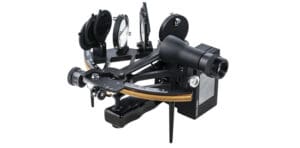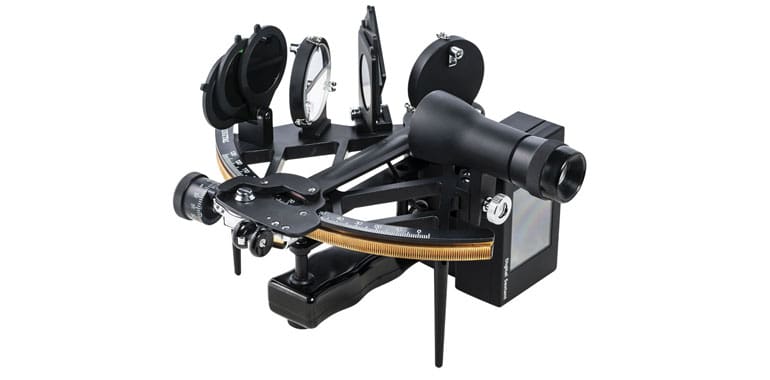
Sextants are wonderfully analog optical devices. A sextant user from the 1850s would have little problem using a modern sextant. Now a company in South Korea has begun offering something it calls the Korea Digital Sextant (KDS) that digitalizes the venerable sextant to make celestial navigation nearly automatic. The company is billing this device as the ultimate backup for GPS for both commercial and recreational mariners.
The application of digital technology to celestial navigation started a long time ago, of course. The first pocket calculators that ran programs could be used to handle the number-crunching of sight reduction and the task of pre-calculating what bodies would be available to shoot based on your DR position and the date. The most widely used of these early programs ran on the HP line of calculators that famously used the reverse polish notation (RPN) data entry system of those devices. In RPN, you add 6 and 3 by entering 6, 3, +. The operand (addition, subtraction, division or multiplication) is entered last. This approach took some getting used to, but studies showed it was a faster approach to data entry and provided some data handling advantages in early calculators.
Other celestial navigation programs were developed using different types of calculators not based on RPN. Still later, DOS- and Windows-based programs became available for the PC. Now, of course, there are a variety of programs for PCs, Macs, smartphones and tablets and even Web-based apps that can calculate celestial navigation values and plot those solutions on the screen.
In an effort toward total digitalization, there also are apps available that make use of a smartphone or tablet’s camera to measure the angles of celestial bodies. While these are clever attempts at a smartphone sextant, they can’t match the optical accuracy of a modern metal sextant.
The KDS product is based on Chinese-manufactured Astra IIIB sextants. These are well-made instruments that provide excellent accuracy for the price — many modern celestial navigation practitioners own Astras.
How does the KDS convert a standard Astra IIIB into a digital sextant? One key is to equip the index arm of the sextant with an accurate angle encoder. According to the KDS, the unit’s angle encoder can read the position of the index arm with impressive precision. According to Dr. Youngseop Lee, the developer of the KDS, the encoder can read angles as small as five seconds of arc, which is one-twelfth of an arc minute. Dr. Lee says that in practical terms the angle readout of the sextant is three-tenths of a minute (0.3’) — excellent accuracy for even an accomplished sight taker.
The Astra sextant is further modified by adding a box to the top of the handle that contains the computing chip and circuit board, as well as modifying the light switch built into the handle to instead send a signal to the computational circuits.
Given these modifications how does the KDS work? The operator first finds the instrument’s index error and enters that into the KDS computer. The operator also enters the name of the body being shot into the computer. Then he or she finds the desired celestial body in the sky, brings it down to the horizon, swings the arc to make sure the sextant is vertical and then presses the button on the handle. This tells the computer to read the angle of the index arm. From here the operation is automatic. The computer can determine a LOP from a single sighting of the sun or a star, or the operator can add additional sights to the session and the KDS will calculate a fixed position in a matter of seconds. The KDS can also use sights of the sun taken during the course of a day to calculate a running fix of the sun.
For the navigator, the KDS means that it is only a question of taking a few sights to get one’s lat/long position immediately. No need for consulting the Nautical Almanac or sight reduction tables. And there’s no need to write down numbers and transfer those to a calculator or smartphone or tablet app. The KDS is an ingenious backup system to GPS that requires only the sight-taking element.
While it probably won’t lead to a renaissance of celestial navigation with voyagers, the KDS is an intriguing, updated approach to doing celestial navigation and not relying blindly on satellite navigation while at sea. At press time, a price for the KDS has not been released. n

